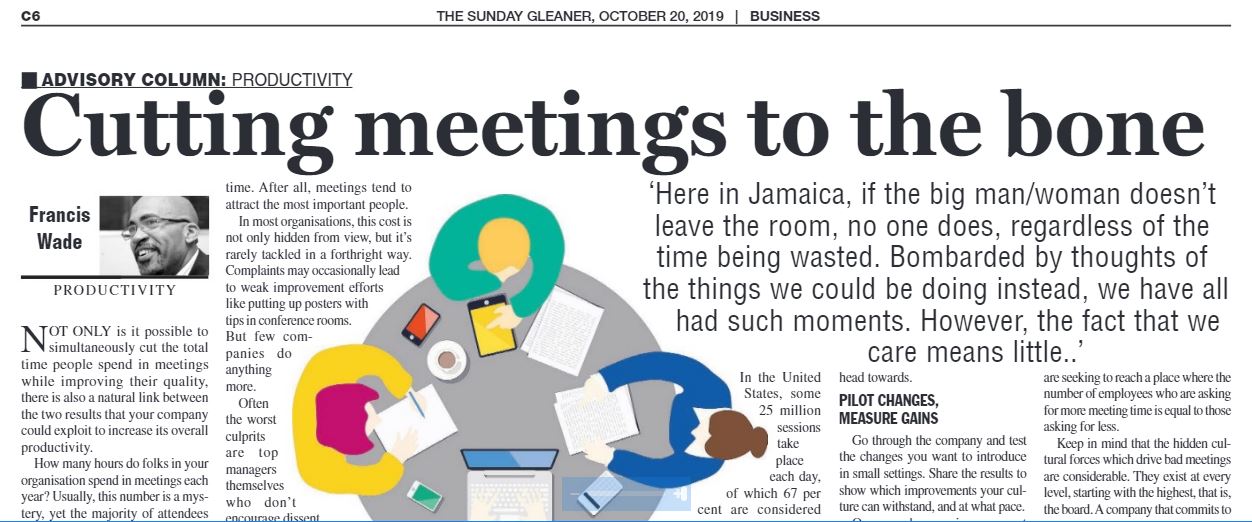Is it possible to simultaneously cut the total time people spend in meetings while improving their quality? Not only is it possible, but there is a natural link between the two results that your company could exploit to increase its overall productivity.
How many hours do folks in your organization spend in meetings each year? Usually, this number is a mystery, yet the majority of attendees would agree that it’s too high.
You may know from bitter experience the painful minutes lost in a poorly run meeting.
Perhaps it took twice as long as it should have. Maybe you would have bolted out the door if there were no social downside for doing so. Here in Jamaica, if the big man/woman doesn’t leave the room, no-one does, regardless of the time being wasted.
Bombarded by thoughts of the things we could be doing instead, we have all had such moments. However, the fact that we care means little. The larger cultural forces at play keep us in check, perpetuating a measurable travesty which costs the best employees’ precious time. After all, meetings tend to attract the most important people. In most organizations this cost is not only hidden from view, but it’s rarely tackled in a forthright way. Complaints may occasionally lead to weak improvement efforts, like putting up posters with tips in conference rooms. But few companies do anything more.
Often the worst culprits are top managers themselves who don’t encourage dissent, thereby making the problem harder to solve.
But if your company decided to do something one day, what process should it follow so that it can get to a place where no-one can recall a badly run meeting?
1. Measure the impact
It’s not hard to make a decent estimate of the total cost of meetings: all that’s needed is careful tracking. Some companies ask their administrative assistants to account for these statistics which are fed into a central database. Sunk costs like those related to the room are ignored: only the total time spent in the meeting by participants is counted.
As you may expect, this cost varies by level of attendee. A meeting of executives is the most expensive because it includes the highest-paid employees.
Expect big numbers. Studies show that some 35% of a middle manager’s time, and 50% of executive time, is spent in meetings. In the US, some 25 million sessions take place each day, of which 67% are considered failures.
2. Analyze meeting issues
Collect information on the faults which proliferate in meetings. Do they start late? Is the purpose unclear? Is the agenda a secret? Is there no end time set? Should they never have been called to begin with?
These common mistakes are the reasons why productivity is low in these gatherings. Poll staff to uncover other causes at play which are peculiar to your culture.
3. Create targets
Take a conservative estimate of the improvements which can be made if behaviors were to change. Don’t pick the maximum savings. Instead, use a more realistic mid-point as a goal for everyone to head towards.
4. Pilot changes
Go through the company and test the changes you want to introduce in small settings. Share the results to show which improvements your culture can withstand, and at what pace.
5. Implement
Once you have an improvement plan, implement it using the best change management techniques. You will have to work around the un-productives: those who benefit from bad meetings. Don’t underestimate their willingness to hide their lack of productivity.
6. Measure the Gains
At the end, determine how much has been saved in hard numbers, and also gauge the overall experience of your staff. Use both metrics to declare whether or not the targeted improvements have been made.
Look for discrepancies. Staff may point out where a cancelled standing meeting is causing problems, for example. But don’t overreact. You are seeking to reach a place where the number of employees who are asking for more meeting time is equal to those asking for less.
Keep in mind that the hidden cultural forces which drive bad meetings are considerable. They exist at every level, starting with the highest i.e. the board. A company that commits to achieving the same results with fewer meeting hours makes a public commitment to work-life balance. Why?
The sad truth is that there are employees who are coming in early and staying late because they have too many meetings. Act in everyone’s interest by cutting this form of corporate waste to the bone.
http://jamaica-gleaner.com/article/business/20191020/francis-wade-cutting-meetings-bone

